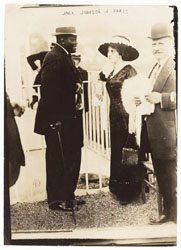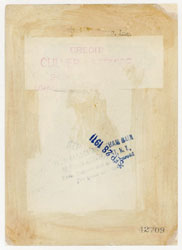HEAVYWEIGHT BOXING CHAMPION JACK JOHNSON WITH WHITE WIFE IN PARIS, 1911
GEORGE GRANTHAM BAIN PHOTO $800. USD
Vintage press photograph of Jack Johnson and his wife, Etta. At the top of the photo: "JACK JOHNSON IN PARIS."
There is a logo in the light space to the left of Jack's lower leg.
There are stamps on the back for Culver Pictures and George Grantham Bain. Also stamped on the back: "SEP 28 1911" and "42709."
UNMOUNTED.
SIZE. Approximately 6 7/8 x 4 15/16 inches.
CONDITION. Some wear around edges and at corners. A few creases. Scratches on and to the left of Etta's waist, which are more apparent when tilted. A few tiny spots. Discoloration and residue from glue on the back.
APPEARANCE. Deep and rich tones. Nice interaction between Jack and Etta, especially her expressive eyes.
JACK JOHNSON. "Jack Johnson (born March 31, 1878, Galveston, Texas, U.S.—died June 10, 1946, Raleigh, N.C.) was an American boxer who was the first African American to become heavyweight champion. He is considered by many boxing observers to be one of the greatest heavyweights of all time.
Johnson fought professionally from 1897 to 1928 and engaged in exhibition matches as late as 1945. He won the title by knocking out champion Tommy Burns in Sydney on December 26, 1908, and lost it on a knockout by Jess Willard in 26 rounds in Havana on April 5, 1915. Until his fight with Burns, racial discrimination had limited Johnson's opportunities and purses. When he became champion, a hue and cry for a 'Great White Hope' produced numerous opponents.
At the height of his career, the outspoken Johnson was excoriated by the press for his flashy lifestyle and for having twice married white women. He further offended white supremacists in 1910 by knocking out former champion James J. Jeffries, who had been induced to come out of retirement as a 'Great White Hope.' The Johnson-Jeffries bout, which was billed as the 'Fight of the Century,' led to nationwide celebrations by African Americans that were occasionally met by violence from whites, resulting in more than 20 deaths across the country.
In 1913 Johnson was convicted of violating the Mann Act by transporting a white woman—Lucille Cameron, his wife-to-be—across state lines for 'immoral purposes.' He was sentenced to a year in prison and was released on bond, pending appeal. Disguised as a member of a black baseball team, he fled to Canada; he then made his way to Europe and was a fugitive for seven years.
He defended the championship three times in Paris before agreeing to fight Willard in Cuba. Some observers thought that Johnson, mistakenly believing that the charge against him would be dropped if he yielded the championship to a white man, deliberately lost to Willard. From 1897 to 1928 Johnson had 114 bouts, winning 80, 45 by knockouts.
In 1920 Johnson surrendered to U.S. marshals; he then served his sentence, fighting in several bouts within the federal prison at Leavenworth, Kansas. After his release he fought occasionally and performed in vaudeville and carnival acts, appearing finally with a trained flea act. He wrote two books of memoirs, Mes Combats (in French, 1914) and Jack Johnson in the Ring and Out (1927; reprinted 1975). He died in an automobile accident." (source: Encyclopedia Britannica)

